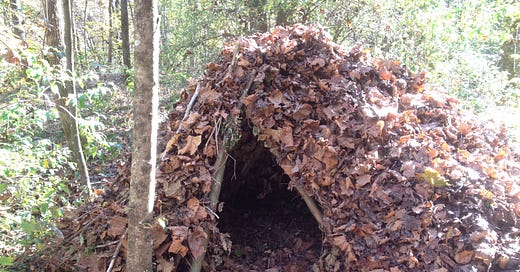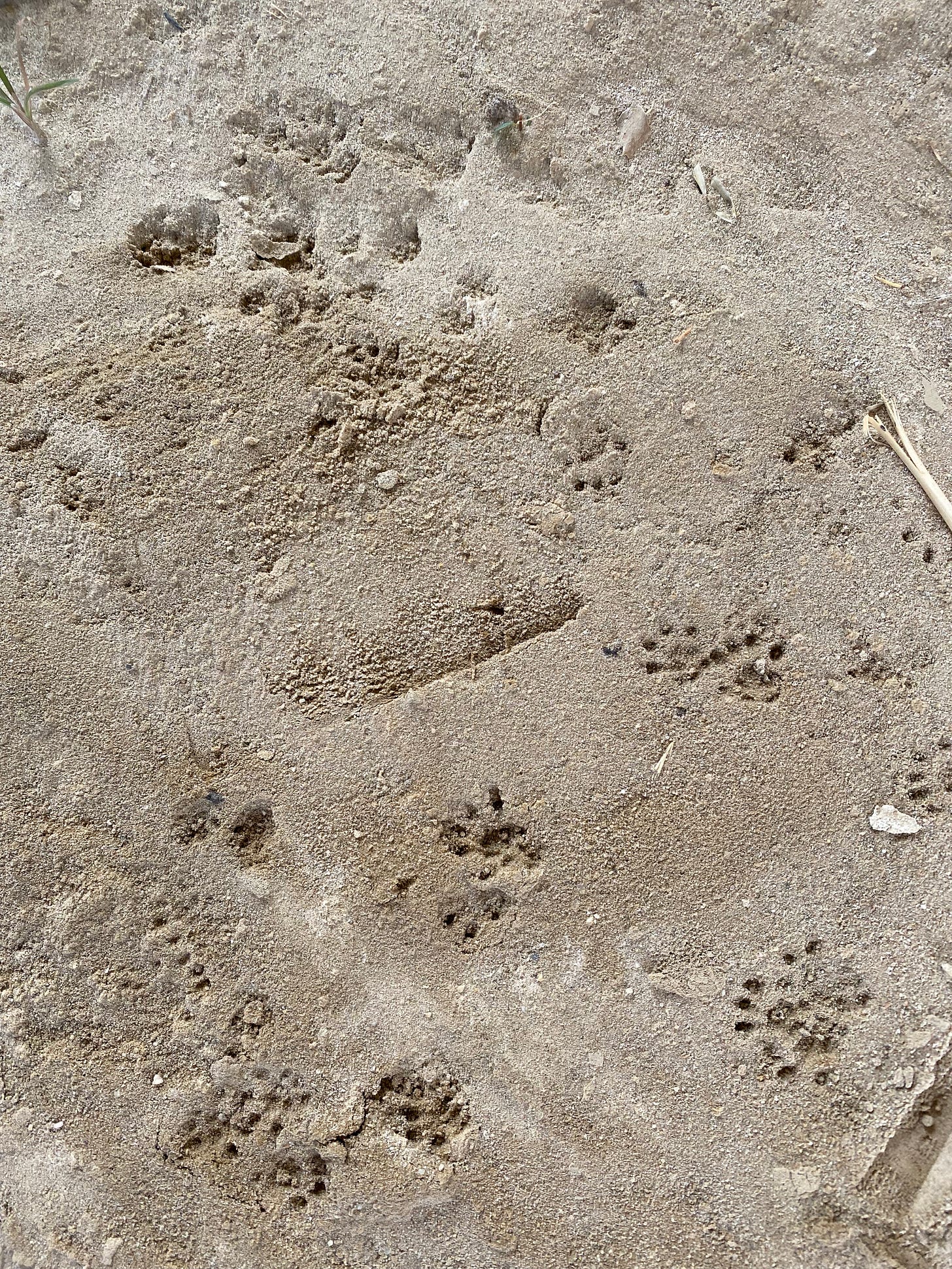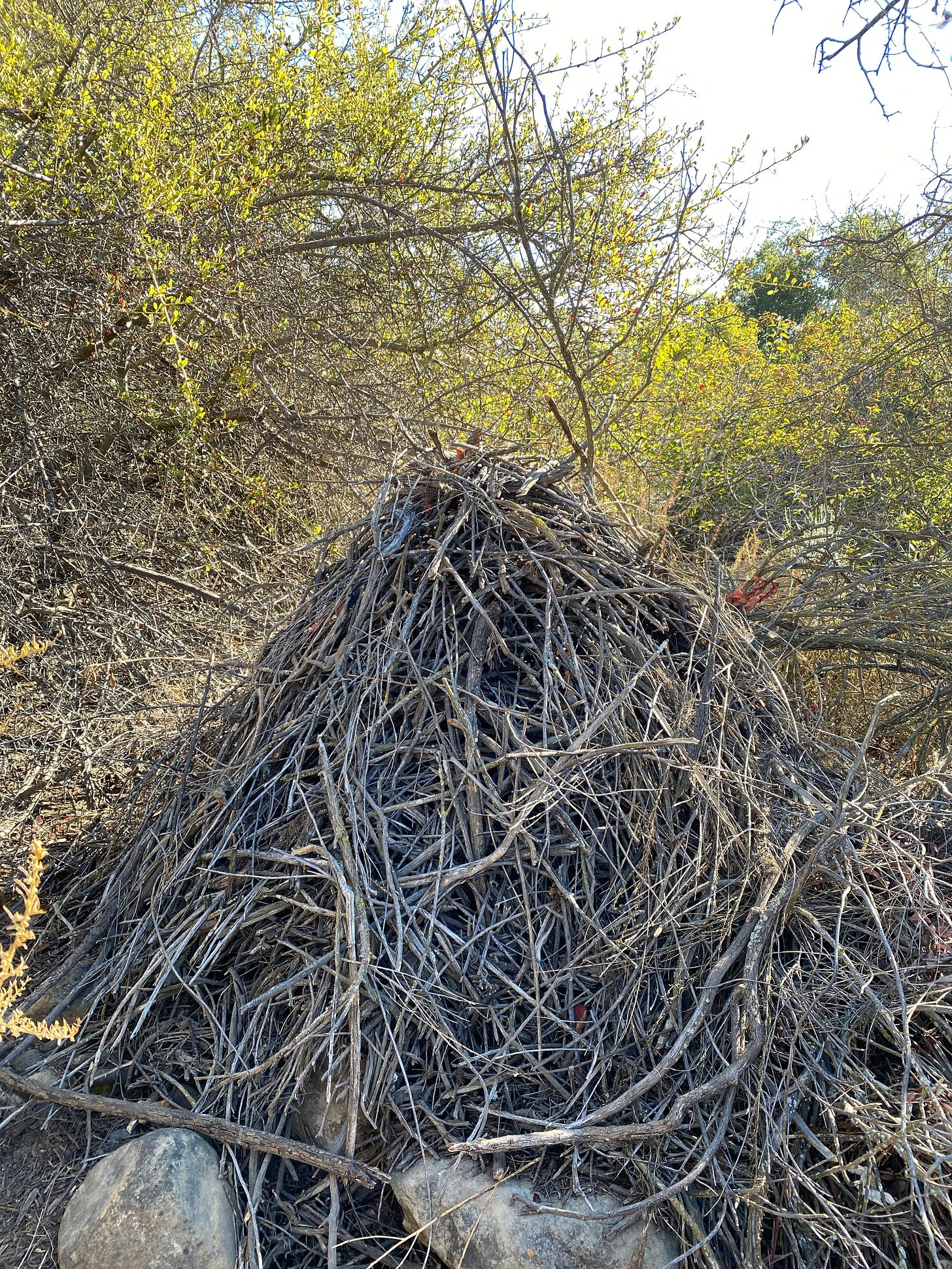Last light, stick in hand. I’ve no flashlight, so work must be quick. I search the understory for a certain ground: level, rootless, rock-free. Here. I use a large forked branch like a rake, and pull leaves to the center of the pile. More–I widen the diameter of my search, pulling more and more rotting dry detritus to the center. With a pile roughly the size of my body, and higher than my ankles, I’m finally satisfied, and throw my sturdy rain poncho over the loose stack. It's a mattress of sorts, which serves both to pad my body against the hard ground, but more importantly, insulates my body from the cold earth.
I learned after the first night that even with my blanket, the cool ground beneath me will sap all my warmth unless I create a layer between my body and the immense body of this planet. I am on a guided survival training. Two weeks in the desert southwest, with a knife, water bottle, water purification, a rope and a blanket. It’s not much, but it's enough–I’ve found–with some basic knowledge and after learning a few knife and rope skills.
So every evening as the dusk arrives, I and the other survivalists in the course with me follow the same ritual. If it’s very cold–which it often is, since we are at between 5000-8000 feet of elevation–we band together, sometimes in pairs, other times in groups of three or more, and make a large pile of leaves and share a bed. The warmth of other bodies can remarkably ward off frosty air, even when bedding is sparse.
In the two weeks of the experience, I thought a lot about how in the modern world we take for granted that heat can be obtained so easily from an external source. If it is too cold outside in the crisp fall, I can walk inside, and if I’m still cold, I simply turn on a thermostat to ignite a heat source. In the high desert where we practiced “survival,” our only heat source was our own bodies (further complicated by a fire ban due to extended regional drought). So I learned quickly the value of layering clothing as a sort of second skin to hold in my own metabolic heat, and was highly motivated to learn the skill of making bowdrill fire embers, even if we were not able to actually make large fires. In the absence of having external fire, we had to hold fastidiously onto the heat of our own internal fire.
One day while walking to our next camp, we saw a collection of big rounded masses in an otherwise open field. They looked like large debris collections, as if someone had cleared the field of brush and piled it up, perhaps to burn. However, on closer look, each one had a doorway. These structures are often called wickiups, an Algonquin word for this type of shelter. Many survival courses teach how to build this kind of structure since it is fairly easy to build and provides warmth and cover.
There are a few ways to create one, but one simple procedure is to build an arch with sturdy branches or poles, and then lean poles against the arch in a half-circle arrangement. These can be tied together, and then, depending on one’s time and skill, one can weave sticks between the poles, or simply lean more and more until a sturdy wall is created. Onto this more and more leafy debris is placed, so that the walls become thick and provide wind block and insulation. A quick survival shelter can be made with the simplest version of piles of woody and leafy vegetation leaned against the walls, while a more permanent structure might have tightly woven walls, perhaps with bark woven into the framework to create a rainproof structure. On the last night of our time together, we had the opportunity to sleep in one of these shelters. Though the structure is quite simple, after having slept in the open air in mattresses of leaves for two weeks, it felt luxurious.
Skin, clothes, duff bed, shelter: these are all ways to shore up heat loss. Like all matter, the human body is itself bound to the laws of physics. Our metabolic heat gets lost in four ways:
Radiation: Radiation creates the transfer of heat through electromagnetic waves. The animal body continuously emits infrared radiation (which is why infrared cameras work), and the amount of heat loss depends on the temperature gradient between the body and the surrounding environment.
Conduction: Conduction is the transfer of heat through direct contact with another material. When the body comes into contact with a cooler surface (for instance, the ground), heat moves away from the warmer body to the colder material, promoting heat loss.
Convection: Convection involves the transfer of heat through the movement of air or fluid. When air or fluid comes into contact with the skin, it absorbs heat from the body's surface, promoting heat loss.
Evaporation: Evaporation is the conversion of liquid to vapor which creates heat loss. Sweating is a crucial physiological mechanism, as the evaporation of sweat from the skin's surface dissipates heat and cools the body.
Humans have responded to heat loss at night with various types of bedding for a long time. Archaeologists in South Africa have found multiple sites showing how ancient humans slept. In Sibudu cave, mattresses were made of fifteen layers of sedges and rushes woven together. The oldest of these was carbon dated to be 77,000 years old.1 One of the main plants used in the mattress is river wild-quince, which has an insect repellent oil. A much older site dated to around 200,000 years ago in the Lebombo mountains shows evidence that humans here slept–similar to how we were taught at my survival class–on a pile of grasses.2 The vegetation would have served to insulate the people sleeping, and the mattress pile was placed atop ashes, which is thought to be a technique to keep biting insects like ticks at bay.
………………..
On my first track and sign evaluation, for one of the questions, an assistant led myself and another participant through some chaparral scrubs. She pointed to a large pile of sticks and brush, heaped up approximately 3 feet high, and probably 4-5 feet across. I was baffled. I was new to the area, and did not have a good sense of the animal inhabitants. I didn’t think beavers lived in this area, but had no idea what else might leave such a structure. I answered beaver, and to this day, I feel a bit embarrassed when I think about it.
I’ve since learned about woodrats, and how they spend their lives nipping off the ends of branches and pulling debris into large piles, often supported by the base of a shrub, or next to a pile of rocks, in order to create middens many times their size in which to nest. The creatures then gnaw off the branches to create passageways and rooms within the structure. As the name suggests, they are rodents, and eat a lot of vegetation, often using their teeth to scrape the wet green cambium layer just under the bark of trees and shrubs for sustenance. They also hoard seeds and other vegetation in “pantry” rooms within their large dens. Piles of capsule-shaped scats lie near nesting sites, and these fecal pellets are easily distinguished by the appearance that they are filled with sawdust.
Like all rodents, woodrats have four obvious toes in their front feet, and five in the hind. If you study their tracks, the toes are bulbous and large compared to other rodent tracks. Their furry tails help them balance as they navigate climbing bushes, trees, and scurrying across limbs.
But their most charismatic feature, the one I mistook for a beaver lodge, is what makes them stand out in the landscape. Woodrats create massive piles of branches in which they create chambers used for nesting, for food storage, and sometimes for latrines. Stick by stick they build these massive structures. The clever beasts nip off leaves of insect repelling herbs and trees to line their nesting chambers, much like the ancestral human practice found in archaeological sites mentioned above. In my area, they use bay laurel or sometimes sagebrush to keep insects away.
We don’t know exactly when, or why, rodent ancestors of woodrats began building middens.But we know they have been doing so for a very long time. We can imagine some moment when a rodent, caught in a storm, sought shelter from rain, clumsily pulling twigs toward itself to create a shelter. Or perhaps, a rodent found a pile of debris in a river floodplain, and found that it could add more twigs and biomass in order to make an even more water and windproof nest. Whatever it was, it worked, and it worked so well that it became a survival skill passed on from generation to generation, until it became a feature of this particular rodent.
Just as I learned that clothing, mattress piles, and even stick and debris structures act like an extra layer of skin to help retain heat, woodrat middens also serve as an external organ of sorts. Physiologist J Scott Turner pioneered the nuanced understanding that many organisms create structures that serve as external organs in order to aid their survival or reproduction.3 Termite mounds, which were the subject of his main research, represent a classic example. Mound building termites generally inhabit very hot and arid environments–places like Australia, Africa, and South America. These social insects work together to create large pillars of dirt which function as a thermal regulator. Termites maintain vents through the mound which can be opened and closed in order to facilitate the flow of heat and air in order to keep the nest at the perfect temperature for their larva to grow. Other key examples of extended and external organs are mole crickets, which create a trumpet shaped tube in the dirt in order to strengthen the range of their chirping to attract mates, and diving spiders who create a web that functions as an external lung when they dive underwater to hunt for food. Woodrats, similar to termites, thermally regulate an otherwise often highly variable temperature with the regulating mass of woody debris in their nest.
These large collections of debris, often called middens, or dens, or nests, often survive long after the builder, as woodrats generally have a lifespan of 3-4 years. One study of woodrat middens in the American west carbon dated vegetal matter in some of the older nests to 40,000 years old.4 Some of these structures survive so long because of placement in protected rock outcroppings, dry weather, and woodrats’ habit of urinating on their middens which creates a preservative effect. If not inhabited by their own progeny, often other woodrats will find an already created nest and spruce it up for their own use.
However, woodrats are not the only creatures to use these large structures. Many other animals and even plants benefit from the woodrats’ work. Often, the California mouse is found living in abandoned woodrat dens. Other creatures such as lizards and amphibians sometimes share a den, and probably help reduce insect burden without scavenging from their pantries of seeds or vegetation. Despite the many ways woodrats attempt to reduce insect invasions, their nests create perfect habitat for many arthropods, especially in desert areas where the dens especially help to moderate temperature and humidity. Finally, when the structures do begin to decompose, they release nitrogen and other minerals into the surrounding soil, creating blooms of plant nourishment from the decay. The collection of herbaceous material mixed with urine and scat from the woodrats creates pulses of nutrients in the area around the midden.
One aspect of woodrats I’ve not yet mentioned is that they love to adorn their middens with objects. Often these seem to have an aesthetic value–pinecones on the top of the den, or perhaps a bone or a shiny piece of metal they found on the landscape. “This place could be beautiful,” they seem to be thinking–and they make it so.
The dens have such an impact on the local ecology that some scientists have called woodrats ecosystem engineers in their own right. One research article goes so far as to say: “Mammals that collect plant parts and other materials to build structures within which the animals reside may be the terrestrial equivalent of beavers and may function as keystone ecosystem engineers.”5 So I feel at least a bit vindicated in my embarrassing move of calling a woodrat den a beaver lodge.
I want to pause here on what the term “ecosystem engineers” means: a creature who directly or indirectly affects the availability of resources to other species by changing some biotic and abiotic components of the environment. This reminds me of how Andreas Weber defines love as a practice that makes others alive, and in so doing, enlivens oneself.
I’m thinking about woodrat dens as a lasting external organ, a structure of enlivenment, which is also an edifice of love, if we are to agree with Weber. My thoughts bloom with wonder. What are the external organs of my life? What are the structures I have built, or at least contributed towards, which will outlast me?
Globally, humans certainly act as keystone species, always altering our environments. Though an honest assessment must admit that if we are a keystone, in the last 100 years or more, it is towards a progressively bare ecology. Still, I find solace and hope in the possibility of human interventions and artifice contributing towards abundance and fertility of resources for other species.
Cultural burns offer one example of a management tool with its associated social infrastructure that contributes to the health and diversity of landscapes. Cultural burns is a practice of controlled burning areas of the landscape, but tied to specific cultural aspects, such as a tribal calendar or season, which tells a native group when and sometimes why the burning is done.
M. Kat Anderson’s book, Tending the Wild, outlines how controlled burns in California promoted increased diversity and abundance of plants, which also increased the diversity of insects and animals in a region.6 Research in the Amazon in the last few decades shows that its abundance is due, in part, to the efforts of ancient humans to cultivate food forests by promoting many edible species, and by building up rich soil called terra preta in an otherwise thin and depleted soil profile in the basin.7 So humans can be a keystone for abundance and diversity.
Too often, humans serve not as a keystone of fecundity but a lodestone of apocalypse. But I believe if we pay attention to the other-than-human people amidst us, ones like Woodrat, we might learn, like woodrats themselves, to leave legacies of abundance.
To that end, woodrat asks us with sharp tooth and furry ears a handful of questions:
How have you held on to your internal fire? Have you shared it with others?Have you left structures and infrastructures that create shelter or warmth for other bodies? Stick by stick, have you created organs of care? Has your living increased soil richness? Have you made the place more beautiful?
………………….
You don’t even think about it, you simply do. But there is the pleasure of a perfectly placed stick, adding to the pile of branches you carefully selected, cut, and pulled into the appropriate spot. Afterwards, you find a succulent willow and gnaw away at the bark, scraping juicy cambium into your mouth and feel satisfied. Full, you scuttle down and back to the den, where you squeeze into the entrance you likewise trimmed to an exact fit to your body with those ever growing teeth, the sharp necessity for your thriving. As you enter, a fence lizard scuttles away, able to wriggle its flat body between branches, unencumbered by the tight mesh of woody material. You don’t mind, as your guest eats the six-legged creatures which love to feast on the cache of seeds in your pantry, and also consumes the ticks which would love to snack on you. You know the maze of passageways and rooms by heart, and don’t need light to navigate your mansion. A twist round the corner and you find yourself back in your nest, lined with thistle down to keep it soft and warm. Your nestling babies clamor and you lay down, allowing them to suckle. As they feed, you nibble bits of bay leaf in the nest to release more aromatic scent that wards off the fleas. You don’t know it, but this place will long outlive you. Perhaps one of these suckling babies will take over this nest after its eyes have opened and it can navigate the world on its own. Or perhaps a deer mouse will take up residence and benefit from your tireless energy. But right now, you rest, for a moment, in this organ born of will and work, this shelter for bodies, this labor of love.
https://www.smithsonianmag.com/smart-news/archaeologists-find-200000-year-old-bedding-south-african-cave-180975592/
Turner, J Scott. The Extended Organism: The Physiology of Animal-built Structures. Cambridge: Harvard University Press, 2002.
Whitlock C. Packrat Middens. The Last 40,000 Years of Biotic Change. Julio L. Betancourt, Thomas R. Van Devender, and Paul S. Martin, Eds. University of Arizona Press, Tucson, 1990. viii, 469 pp., illus. $55. Science. 1990 Nov 16;250(4983):1021-2. doi: 10.1126/science.250.4983.1021-a. PMID: 17746928.
Herman Campos, Wiebke J. Boeing, Heather L. Throop, Decaying woodrat (Neotoma spp.) middens increase soil resources and accelerate decomposition of contemporary litter, Journal of Arid Environments, Volume 171, 2019, 104007, ISSN 0140-1963, https://doi.org/10.1016/j.jaridenv.2019.104007. (https://www.sciencedirect.com/science/article/pii/S0140196318307559)
https://www.ucpress.edu/books/tending-the-wild/paper
https://www.uapress.ua.edu/9780817358327/cultural-forests-of-the-amazon/






